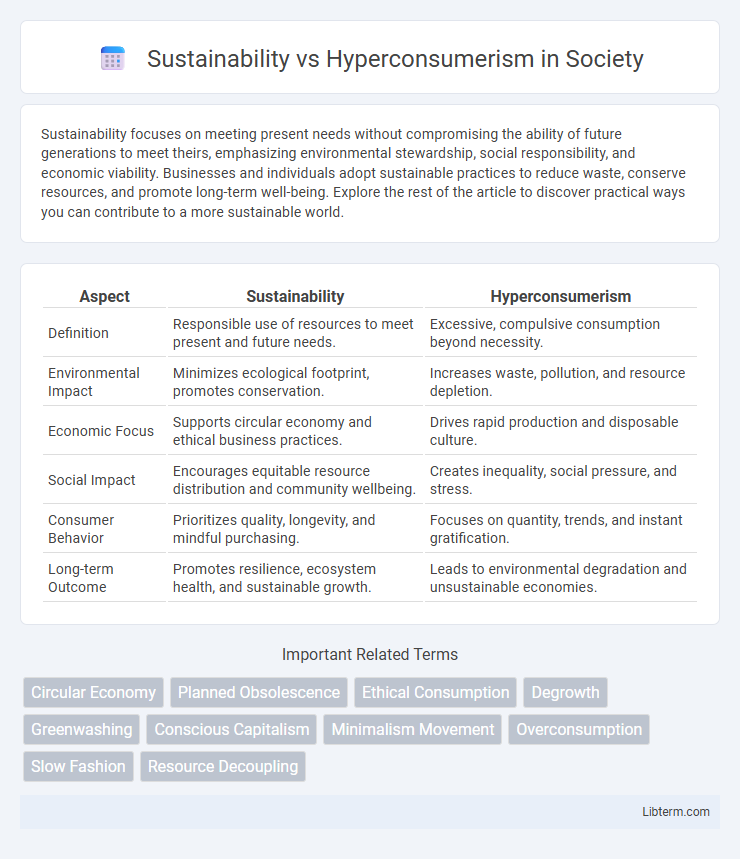Sustainability focuses on meeting present needs without compromising the ability of future generations to meet theirs, emphasizing environmental stewardship, social responsibility, and economic viability. Businesses and individuals adopt sustainable practices to reduce waste, conserve resources, and promote long-term well-being. Explore the rest of the article to discover practical ways you can contribute to a more sustainable world.
Table of Comparison
| Aspect | Sustainability | Hyperconsumerism |
|---|---|---|
| Definition | Responsible use of resources to meet present and future needs. | Excessive, compulsive consumption beyond necessity. |
| Environmental Impact | Minimizes ecological footprint, promotes conservation. | Increases waste, pollution, and resource depletion. |
| Economic Focus | Supports circular economy and ethical business practices. | Drives rapid production and disposable culture. |
| Social Impact | Encourages equitable resource distribution and community wellbeing. | Creates inequality, social pressure, and stress. |
| Consumer Behavior | Prioritizes quality, longevity, and mindful purchasing. | Focuses on quantity, trends, and instant gratification. |
| Long-term Outcome | Promotes resilience, ecosystem health, and sustainable growth. | Leads to environmental degradation and unsustainable economies. |
Understanding Sustainability: Principles and Practices
Sustainability involves adopting principles and practices that prioritize long-term ecological balance, resource efficiency, and social equity to reduce environmental impact. Key practices include circular economy models, renewable energy use, and sustainable supply chain management, which collectively diminish waste and carbon emissions. Emphasizing sustainability challenges hyperconsumerism by promoting mindful consumption and durable product design over excessive, short-lived material acquisition.
The Rise of Hyperconsumerism: Causes and Effects
The rise of hyperconsumerism is driven by aggressive marketing strategies, technological advancements, and the proliferation of social media platforms that encourage constant consumption. This phenomenon leads to increased environmental degradation, resource depletion, and waste generation, undermining sustainability efforts globally. Consumer culture fueled by hyperconsumerism exacerbates carbon emissions and threatens biodiversity, intensifying climate change challenges.
Environmental Impact: Sustainability vs Hyperconsumerism
Sustainability emphasizes reducing carbon footprints, conserving natural resources, and minimizing waste to combat climate change and preserve ecosystems. Hyperconsumerism drives excessive production and consumption, leading to increased greenhouse gas emissions, resource depletion, and landfill overflows. Prioritizing sustainable practices mitigates environmental degradation caused by the unsustainable demand patterns in hyperconsumerism.
Economic Models: Circular Economy vs Linear Consumption
The circular economy model emphasizes resource efficiency by promoting recycling, reusing, and reducing waste, contrasting sharply with the linear consumption model based on a "take-make-dispose" approach. Circular systems foster sustainable economic growth through closed-loop production processes that minimize environmental impact and support long-term resource availability. Hyperconsumerism, driven by linear consumption, accelerates resource depletion and environmental degradation, undermining economic sustainability and ecological balance.
Social Consequences: Wellbeing in a Consumer-Driven Society
Hyperconsumerism often leads to increased social inequality and diminished mental wellbeing as individuals prioritize material possessions over meaningful interactions. Sustainability promotes community resilience and long-term health by encouraging mindful consumption and resource-sharing practices. This shift supports improved social cohesion and reduces stress associated with constant consumer pressures.
Fashion and Fast Consumption: The Cost of Trends
Fast fashion accelerates hyperconsumerism through rapid trend cycles, resulting in extensive environmental degradation and overwhelming textile waste. The sustainability movement in fashion emphasizes using eco-friendly materials, ethical production, and reduced consumption to mitigate carbon emissions and water pollution. Consumer choices favoring durable, timeless apparel over disposable garments significantly decrease the industry's ecological footprint and promote circular economy practices.
Technology’s Role: Enabler or Solution?
Technology serves as a critical enabler in promoting sustainability by optimizing resource efficiency, reducing waste through advanced recycling systems, and supporting renewable energy integration. Innovations such as IoT sensors, AI-driven analytics, and blockchain for supply chain transparency empower businesses to monitor environmental impact and adopt circular economy practices. However, unchecked technological advancements can also exacerbate hyperconsumerism by encouraging planned obsolescence and excessive digital consumption, highlighting the need for responsible innovation and policy frameworks.
Changing Mindsets: Minimalism and Conscious Choices
Shifting from hyperconsumerism to sustainability involves embracing minimalism and making conscious choices that prioritize quality over quantity. Consumers increasingly value eco-friendly products, ethical brands, and reduced waste to lower their environmental impact. This mindset change fosters long-term resource conservation and supports sustainable economic models centered on responsible consumption.
Policy and Corporate Responsibility: Driving Sustainable Change
Policies mandating transparent supply chain reporting and strict environmental standards compel corporations to adopt sustainable practices, reducing ecological footprints significantly. Corporate responsibility programs integrating renewable energy usage and circular economy principles help shift business models away from hyperconsumerism-driven overproduction. Public-private partnerships further accelerate sustainable innovation by aligning government incentives with corporate sustainability goals.
The Future Outlook: Balancing Needs and Planetary Boundaries
Sustainability demands a systemic shift towards resource efficiency and renewable energy, aiming to align economic growth with planetary boundaries. Hyperconsumerism drives excessive consumption patterns that deplete natural resources and increase waste, posing significant threats to environmental stability. The future outlook hinges on adopting circular economy models and promoting responsible consumption to balance human needs with ecological limits, ensuring long-term planetary health.
Sustainability Infographic

 libterm.com
libterm.com